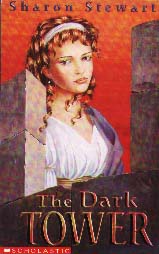|
________________
CM . . . .
Volume V Number 1 . . . . September 4, 1998
excerpt:
My dreams were haunted. One night I awoke to the echo of my own screams, and lay awake weeping until the first cold light crept through the shuttered windows. That morning only my fear that the guards would force their way in if I didn't answer the door made me get up and drag on my clothes. I picked up a knitting needle and, not really knowing why I did it, scratched a message on the plaster wall of the chamber:These words of Marie Therese Charlotte de France, daughter of King Louis XVI and Queen Marie Antoinette, resonate with anguish at her imprisonment in the Tower during the blood bath of the French Revolution which she alone of her immediate family survived. Stewart bases The Dark Tower, a novel written in diary format, on The Journal of Madame Royale, the official record of Marie Therese's ordeal. Nicknamed Mousseline by the family, the princess insists "the whole story, the real story, exists only in my innermost thoughts. The government has no right to my soul." The reader meets 11-year old Mousseline beset by "sorrows," but reasonably secure with the family at Versailles in June 1789. However, the momentous changes resulting from the emerging new social order intrude upon the royal lives, and, by fall, the family is required to move to Tuileries Palace in Paris as virtual prisoners. In spite of Louis XVI's many concessions to the National Assembly in the establishment of a constitutional monarchy, as he tells Mousseline, "the people's minds are inflamed with the Revolution, and they think it is the answer to all their needs." By mid-1792, the family is imprisoned in the Tower. The revolutionary themes of liberty, equality, fraternity, do not apply to them. First Louis, then Marie Antoinette and royal family members who did not flee France bow before the guillotine; Charles dies of neglect and mistreatment - only Mousseline survives the terror. Mousseline's awareness of the turmoil of her era develops from puzzlement to outrage, fear, anger, and finally, to grim acceptance of her fate. Letters from her companion Pauline's friend, Sophie, who is a member of the bourgeoisie, the emerging powerful middle class, reflect the social and political conflict between the privileged and the underprivileged. Mousseline witnesses the fall of the absolute monarchy, the dissolution of the feudal system, the freeing of the peasants, and the loss of power of the aristocracy as France moves from feudalism to capitalism. Stewart juxtaposes Mousseline's growing awareness with her confusion as the safe and orderly world in which she has lived changes dramatically. She comes of age during her imprisonment. Only after Robespierre's fall do her living conditions improve and does she learn that she alone survives. In December 1795, Mousseline, now 17, gains her freedom through a prisoner exchange and flees to Austria. In a brief epilogue, Stewart somewhat awkwardly sketches the remaining years of Mousseline's life as "stitches of memory, stitches of time." Fans of historical fiction will appreciate this glimpse of the French Revolution viewed through the eyes of the princess history appears to have forgotten. Recommended. Darleen Golke is the teacher-librarian at Fort Richmond Collegiate in Winnipeg, Manitoba.
To comment on this title or this review, send mail to cm@umanitoba.ca.
Copyright © 1998 the Manitoba Library Association.
Reproduction for personal use is permitted only if this copyright notice
is maintained. Any other reproduction is prohibited without
permission.
Published by
TABLE OF CONTENTS FOR THIS ISSUE - SEPTEMBER 4, 1998.
AUTHORS |
TITLES |
MEDIA REVIEWS |
PROFILES |
BACK ISSUES |
SEARCH |
CMARCHIVE |
HOME
|

